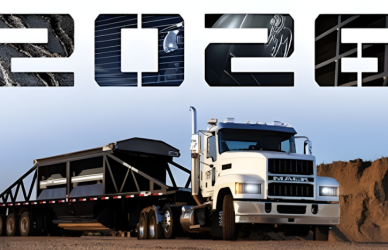The Federal Motor Carrier Safety Administration (FMCSA) has sanctioned the use of pulsating brake lights for a select number of trucks, awaiting updated industry standards before broader adoption of this technology.
In a recent decision, FMCSA issued a five-year exemption to Encore Building Products, based in Springdale, Arkansas. This construction material transporter will be permitted to equip its trucks with an electronic braking module developed by Intellistop, Inc.
The Intellistop system temporarily increases the intensity of a truck’s rear lights, flashing them four times within two seconds as brakes are applied, then maintaining steady illumination while braking continues. This approach contrasts with federal regulations mandating that brake lights remain steadily lit.
FMCSA commented, “The agency has determined that granting the exemption to Encore would likely achieve a level of safety equivalent to, or greater than, the level of safety achieved by the regulation.”
This is a significant victory for Intellistop, which had previously sought a broader industry exemption that FMCSA rejected two years ago. The prior rejection was due to concerns that the wide-reaching exemption wouldn’t provide safety measures comparable to regulatory standards, although FMCSA suggested that exemptions for specific motor carriers like Encore might align more closely with its authority.
The decision to approve Encore’s exemption hinges on its limited scope—affecting approximately 223 trucks—and supporting data indicating that enhanced rear signal systems can potentially mitigate rear-end collisions.
FMCSA stated, “Initially restricting the application of this exemption to a limited portion of Encore’s fleet will allow for a comparison between the crash involvement of Encore CMVs [commercial motor vehicles] equipped with the Intellistop device, those without the device, and the overall crash involvement of CMVs operated by similarly sized motor carriers with similar operations and overall safety performance.”
Encore must limit the installation of the module to no more than half of its power units and trailers during the exemption’s first year. Recent statistics from the National Highway Traffic Safety Administration (NHTSA) show that the rear of large trucks (weighing over 10,000 lbs.) is the second most common initial impact point in crashes causing injuries (17%) and fatalities (22%).
Supporting this initiative, the Truck Safety Coalition has advocated for stricter truck equipment standards to prevent collisions involving passenger vehicles. They remarked, “[We support] FMCSA’s exemption to allow for limited field testing of Intellistop’s module ‘in order to collect data and more fully determine the potential safety benefits of this promising approach.’”
Conversely, the Transportation Safety Equipment Institute (TSEI) opposes the exemption. They argue, “We do not believe FMCSA should make the leap … without a thorough consideration of safety data and research with the aim of setting standards (including those related to flash patterns) to ensure consistency across all vehicles equipped with such lamps.”
The TSEI urges FMCSA to reject Encore’s application while suggesting, “the agency to closely study the use of non-steady burning and pulsating lamps and, as appropriate, engage in formal rulemaking to amend [federal regulations] to provide consistency among all vehicles (or vehicle types).”
Source: FreightWaves











